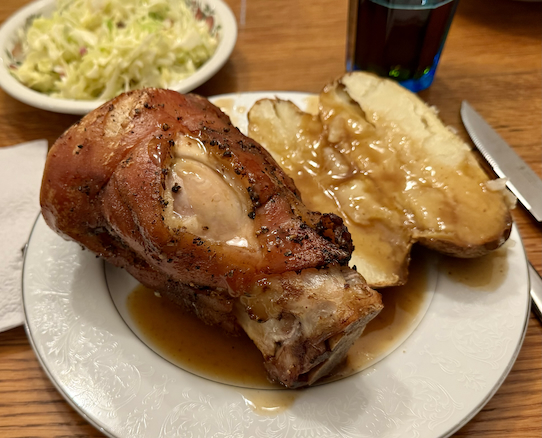Serves 4
- 4 fresh pork hocks (see notes)
- 2 teaspoons coarsely ground salt
- 2 teaspoons peppercorns, partially cracked
- ¼ teaspoon caraway seeds
- 10½ oz can low sodium beef broth
- 16 oz bottle of beer (or more beef broth to keep the dish gluten-free)
- 1 carrot, chopped
- 1 stalk celery, chopped
- thin slices of onion (about 2.5 oz)
- 1 Tablespoon lard (see notes)
- 4 large russet potatoes, very lightly coated with butter or lard
Special equipment
- Mortar and pestle for cracking the peppercorns
Method
- While your oven is preheating to 325°, score the skin of the hocks, preferably in a diamond pattern, but uneven horizontal lines will work, with a very sharp knive. If your hocks are skinless, score the fat, but only very lightly score the meat. Rub in the coarse salt and peppercorns; season with a sprinkle of caraway.
Prick potatoes, coat with grease, and place directly on an oven rack.
Place the hocks in a roasting pan, add the vegies, and the lard if the hocks are skinless, and roast for 3½ hours, turning every 30 minutes so that they brown evenly. After the first half hour, start basting gently with the beer and pouring some of the broth into the bottom of the pan so that the drippings don’t burn. Add liquid as needed; you want to baste the hocks in liquid, not poach them. If you have extra large hocks from the rear of the hog, they’ll need more time. 3½ hour is good for your typical 24 oz, 5-6 inch long hock.
At the 3 hour mark, crank up that oven to 450°. You’re gonna crisp that skin. Turn over after 15 minutes. Feel free to spend more time crisping and turning. It’s part of what makes this dish so special.
When the hocks are complete, remove to a warm dish. Move the roasting pan to the stovetop, remove the vegies, and reduce the juices to a strong sauce. Remove potatoes from the oven, place on each dinner plate and split. Add hocks, and pour the sauce over the hocks and potatoes. Be sure to serve enough sauce so that your patrons can smother their spuds.
Notes
- Procuring the hocks is the hardest part. Smoked ham hocks are easy to find, but that’s not what you want here. You want unsmoked pigs’ forearms.↩ While you can sometimes find meaty looking ankle parts at a butcher that offers pigs feet, don’t be fooled. Those are cut so close to the trotter that they are gristly and bony, not meaty. Make friends with your local pork butcher and order them ahead. You may be surprised to find that even though your butcher smokes his own hocks, it might not be local hocks he’s smoking. Raw hocks freeze very well even if they do take up a lot of freezer space.
It may be difficult to find hocks with the skin intact. The crackling skin is part of the joy of hocks. Do try to find a butcher that sells intact hocks. If unavailable, yes, the meat will be moister when protected by the skin, the seasonings stick better to meat than they do to pork skin, and you’ll have plenty of gravy for the meat anyway. The added lard is to make up for some of the missing underskin fat.↩
Potato dumplings is the traditional accompaniment, but the roasting time is perfect for large baked potatoes, and makes for a very easy-to-prepare meal.
Suggestions
- Try crushed rosemary instead of caraway, or garlic. Or whisk a cup of sour cream into the dregs for the sauce instead of the remaining broth and beer. Or use cognac instead of beer, as prepared by a favored Oberbayern Gasthaus
And while sauerkraut, winekraut, red cabbage, and even pineapple cabbage are considered traditional, we insist on a bunter (‘colorful’) Salat of fresh greens.
If you’re making only one or two hocks, use an iron frying pan instead of a roasting pan to minimize the surface area for the sauce to cook away.


